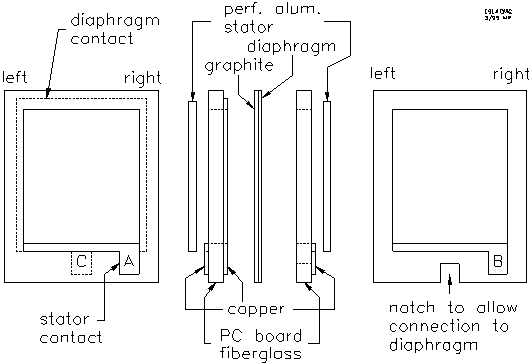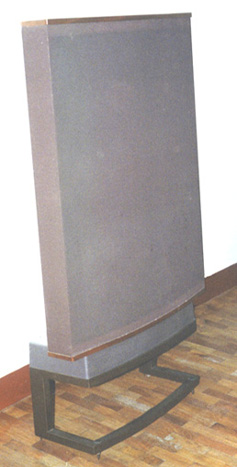The Electrostatic Loudspeakers, of course, are not new; the principle
was known prior to the work of Rice and Kellogg on moving coil speaker.
Various practical examples had appear before, usually as simple tweeter units
with their function confined to handling the frequency spectrum above, say,
1 or 2 kHz. To go much below that presented, so it was thought , too many
theoretical and practical design problems. Those available commercial
examples suffered from many shortcomings, such as poor efficiency,
non-linear distortion and unreliability.
Yet to design engineers of Peter Walker's and Williamson's caliber,
these unsolved problems presented a fascinating challenge, with ultimate
solutions of them promising an exciting prospect since the electrostatic
concept had one particular attraction over conventional speakers using
moving coil driver units. It held out the tempting possibility of being
predictable to a far greater degree than hitherto considered possible, and
offered designers a reliable preview of how a high quality loudspeaker would
perform at the design stage long before prototype construction. This is in
contrast to the "try it and see" approach that even today is often the
dominant technique for design of moving coil or dynamic speaker system.
The basic design of an electrostatic full-range loudspeaker consists
of light, thin plastic diaphragm which is made weakly (slightly) conductive
and suspended centrally between two outer perforated electrodes. The diaphragm
is in fact very light; it weight less than the air layers on either side to
which it impart the sound vibrations. The diaphragm is also given a constant
electric charge from a high voltage polarizing source, the equivalent of
the permanent magnet in a moving coil unit. The driving signal is fed across
the two fixed electrodes, so when one is negative and the other positive,
the diaphragm will move towards one by attraction and by repulsing from the
other. Reverse the phase, as with the audio signal, and the movement is the
other way; a genuine push-pull system and fully symmetrical.
Well designed electrostatic loudspeaker has wide pleasant dispersion
at all frequencies. Ordinary it contains a narrow line- source sector operating
at all frequencies ( bass, midrange, treble ). Adjacent sectors handle mid-range
and bass frequencies. The remaining panel area reproduces bass only. The
result is a speaker that uses the entire radiating surface for bass response
and progressively narrower area as frequency increases, for a wide dispersion
and natural sound.
Now we come to some of the electrostatic speakers many advantages.
Since the diaphragm is driven over its entire surface, it need not to be "fery" stiff
and thus, has little stored energy in itself. Also, because of an excellent
impedance match with the air, the system requires no load in any form of the
acoustic chamber, thus many of the problem associated with cabinets never arise.
Nonlinear distortions are below 0.1 - 0.05% , comparable with the
distortions of a good amplifier.
With electrostatic speakers it seems as the music is coming from somewhere
behind or through the loudspeakers, with a freedom from coloration and distortion
that raises new standards.


ESLAB-ELECTROSTATIC LOUDSPEAKERS SPECIFICATIONS

Impedance: 8 ohm (nominal)
Frequency responce: 35-22,000 Hz
Sensitivity: 84dB, 1 watt/1 meter
Nominal power : 100w
Overload protection : Internal overload protection
Max SPL : 96dB (2 meter)
Dipole Line source,
Dimentions : 65x120x4cm
Weight: 10 kg each
Power supply : 12V/AC external transformer
Non linear Distortions : under 0.02%.
Finish: Oak with black grille cloth

QUAD ESL 63
 QUAD ESL63
QUAD ESL63
I am reproducing the blurb from the
Quad ESL 63 web page because the design idea is just
incredibly ingenious and elegant.
Electrostatic loudspeakers have inherent advantages over conventional loudspeakers. An
electrostatic loudspeaker consists of a very thin plastic membrane suspended between a pair of
conducting perforated plates. The membrane carries an electrostatic charge and is forced to move
by the electrostatic field produced between the plates when the signal voltage is placed across
them. The membrane is very light (the thickness is one tenth that of a human hair in the ESL 63)
and hence has negligible stored energy. Since the electrostatic charge is spread uniformly over the
surface of the membrane it can be made as large as required and a cabinet is not necessary.
Thus the two major causes of coloration in moving coil loudspeakers, which we have come to
regard as the sound of hi-fi, are avoided in electrostatic loudspeakers. The performance of the ESL
63 is a revelation to anybody accustomed to listening through moving coil loudspeakers.
The Quad ESL 63 takes the performance advantages of electrostatic loudspeakers a stage further.
The ideal loudspeaker for stereo reproduction is a single point source reproducing all frequencies.
Loudspeaker engineers have been trying to develop one for more than half a century. If it is not
possible to produce a point source loudspeaker, can we instead make a loudspeaker that to an
observer behaves like one?
Imagine a theoretically ideal point source loudspeaker radiating sound pressure waves and then
imagine a plane in the air a short distance from the source and at right angles to the direction of
propagation. If the air at the plane is made visible in some magical way, we will see concentric
waves radiating out from the center just as they do when a stone is thrown into a still pool. If we
substitute an electrostatic loudspeaker membrane for the plane in the air, make it move in exactly
the same way as the air on our imaginary plane and suppress the imaginary source, the results to an
observer positioned on the far side will be identical to those from the ideal source.
The Quad ESL 63 does exactly this. An ingenious arrangement of concentric electrodes fed by a
sequential delay line produces a sound pressure pattern that is an exact replica of that from an ideal
source placed 30cms behind the plane of the diaphragm. The ESL 63 is a totally homogenous
sound source, phase true and aperiodic, with a frequency response, both on and off axis, quite free
from the irregularities that are inevitable with any multi-way loudspeaker system. It has a very well
controlled directivity characteristic with the result that there is no stereo hot-spot.
A pair of 63s will produce an excellent stereo image over a range of listening positions, which are
as wide as the speakers are apart. Since the loudspeakers can be placed right up to the side walls
the stereo stage can be very wide and the listening position very free. With the very best stereo
recordings, the results are holographic, and moving from one side to the other presents the
orchestra from different points of view.
The result is a loudspeaker of unsurpassed accuracy, which with the right programme material will
produce a more realistic and satisfactory illusion of a live musical performance than has been
possible hitherto. Compact disc provides music at home that is virtually identical to that on the
studio master tape. A number of the leading record companies use the Quad ESL 63 as a
reference monitor, so listening to compact disc at home using ESL 63s is akin to listening over the
recording engineer's shoulder.

 QUAD ESL SERVICE & REPAIR
QUAD ESL SERVICE & REPAIR
 QUAD-COMPANY
QUAD-COMPANY
 QUAD ESL-57 INSTRUCTION BOOKLET
QUAD ESL-57 INSTRUCTION BOOKLET
 MUST SEE: AUDIO DESIGN. (One of the best sites about ESLs)
MUST SEE: AUDIO DESIGN. (One of the best sites about ESLs)
 QUAD ESL63 IMPROVEMENT OR...?
QUAD ESL63 IMPROVEMENT OR...?
For Questions:



 Here You Can Order Videos
Here You Can Order Videos
|
 |
Home Page (Table of Contents)
![[Aaddzz Counter]](http://counter.aaddzz.com/counter.cgi?id=82759)